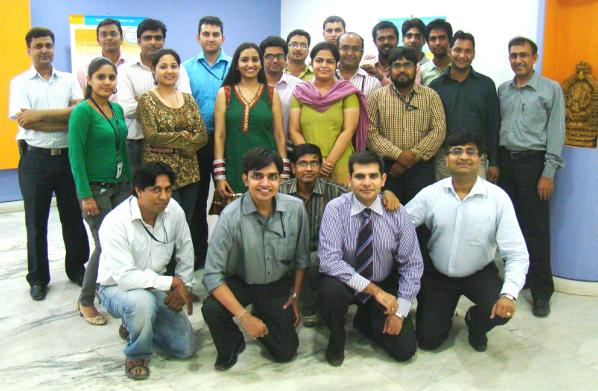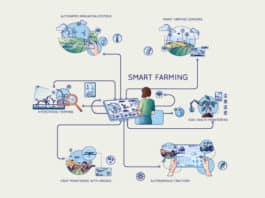
Noida headquartered InfoAxon Technologies erases all doubts around the profitability of an open source business. It uses the “platforming” approach to cement long lasting relationships with its customers.
InfoAxon Technologies began business focusing on proprietary technology back in 2001. But it soon took the plunge into the open source world within a year.
InfoAxon has grown steadily from Rs 20 million in 2003 to Rs 50 million in 2009, and is expected to clock revenues of Rs 100 million this fiscal. Along the way, it has grown from a four-member team to an 80-strong army, comprising open source architects, platform designers, open source evangelists and open source developers. Armed with open source, it has won over customers in the UK, South Africa and India.
The story of InfoAxon Technologies speaks volumes for the profitability of an open source business. “It is true that initially most businesses jumping onto the open source bandwagon didn’t have a profitable business model. However, that was not because you couldn’t have one, but because most of those selling open source and benefiting from it got fixated to the ‘free’ aspect of open source. They discounted the crucial values of open source technology like choice, flexibility and innovation. Thus, they soon hit a dead end on the business road. For companies like ours, which saw open source technology as a development model and participated in and augmented the collaborative work of the community, the business model automatically happened alongside,” says Shubham Nagar, chief executive officer, InfoAxon Technologies.
The open road
Four friends, with a mix of technical, financial and marketing skills, set up InfoAxon Technologies in 2001. Post the dot com bust, they saw tremendous scope in the “offshore outsourcing model” to help global companies reduce time to market and address the skill gap in developing software solutions. They also founded InfoAxon Technologies UK (a 100 per cent subsidiary of InfoAxon Technologies), and began software development using .NET technology for clients like Virgin Media.
Within a year, things began to work well for InfoAxon, which was looking at creating a niche for itself within the software development market. “We had existing customers inviting us to a huge opportunity emerging in the UK public sector. One of our initial customers — the London borough of Camden — was involved in a project funded by the Office of the Deputy Prime Minister (ODPM), which was working towards making all government services available online through a series of projects named the ‘Pathfinder’ projects. To make that happen, local authorities in UK needed a content management (CMS) and knowledge management solution (KMS). No proprietary solution fitting the exact need for ODPM projects was available to the public sector back then. They had two options — to either customise a proprietary solution or go for open source technology. Realising that the former carried the risk of vendor lock-in, the deputy PM’s office decided to support the open source project, APLAWS (Accessible Personalised Local Authority Web Sites). The London borough of Camden, Red Hat and InfoAxon were involved in the project from the start. This marked the beginning of our open source voyage,” says Nagar.
InfoAxon focused on the core architecture of the APLAWS platform and some of its key contributions included the form builder; the ability to go to the main CMS and create dynamic forms; plugins for HTML, news feeds and RSS feeds; a design of the front end CMS layer, etc, which were all path breaking at that time. This is also when InfoAxon, as a company, became entirely convinced about the open source business model.
The early setbacks
However, despite an easy start, selling open source at a time when awareness levels were low wasn’t easy. InfoAxon had to battle mindset issues at a time when proprietary software was the de facto choice. “The initial sales cycles were very long. We had to dedicate substantial time in presentations to explain what open source was, as most customers didn’t understand the model. Thereafter, a lot of information exchange needed to be done to ensure the client remained convinced. Thus, we spent a lot of time and energy in pre-sales legwork. Despite that, many a time, it wouldn’t convert into engagements,” recalls Vineet Dahiya, co-founder and director, InfoAxon Technologies.
“However, this is changing rapidly now, as there are proven open source success stories in almost every field of IT and the industry verticals. Now, there is less open source evangelism required during our discussions with customers. Instead, they straight away engage us in understanding the value we provide to them using open source as a model for innovation. This suits us completely, as we have a wealth of open source expertise and experience and are able to demonstrate our value quite early on, leading to quick engagements,” adds Dahiya.
Charting out a new route to success
The strategy of selling a “complete solution” rather than open source, per se; of looking at every customer as a stream of opportunities/revenue; and using existing customers as doors to reach out to new clients, helped InfoAxon win new business over the years. “We realised very early on that we would be taking a great risk if we focused on customising open source rather than on what the technology can do. Thus, we focused on selling a ‘complete solution’, which were our ‘platforms’ to the customer. Alongside, we used our existing assignments like the APLAWS project to reach out to new customers like the European arm of UNDP, Indian Air Force etc. In a nutshell, our platforming focus soon fell in sync with our business model and value proposition,” says Nagar.
Dahiya adds: “After the APLAWS experience, we realised the opportunity in the public sector and the international development arena, and decided to focus on these sectors. We also kept preaching to the already convinced, like those in the banking and finance sector, who were on the constant lookout for newer technologies and were already bowled over by the open source idea.”
Platforming — the trump card for InfoAxon
“Solution platforms”, also called platforming, wherein various open source tools/platforms were integrated into one solution, was the USP and key differentiator for InfoAxon. “Our experience has taught us that most organisations, which have realised the value of open source or are in the process of realising it, don’t want to implement select open source tools as a quick fix solution, or if they do, they realise quickly that they are on the wrong track. They want to integrate a whole lot of open source technologies and create a unique platform for their needs within their own domain. We provide them such platforms around knowledge management (KM), business intelligence (BI) and content management systems (CMS) with a vision to provide so much more in the future and to do so in diverse domains,” says Nagar.
Since these platforms could be extended to develop solutions for different domains/ markets, they hold the promise of reducing the overall time to market for customers. One of the firm’s noteworthy platforms is “AxonShare”, which is a “collaborative content management platform” that can be used to create content-centric collaboration solutions that help organisations address the challenge of knowledge sharing. It combines collaboration and social capabilities with back-end enterprise content management capabilities to provide end-to-end content and collaboration functionality. “FusionKM” is another workflow enabled social network-based knowledge management platform that provides infrastructure and a robust design by which new services could be built into the solution. InfoAxon is also involved in developing large scale knowledge management platforms with integrated business intelligence for the international development sector.
Is ‘platforming’ a viable business model?
With platforming currently contributing nearly 70 per cent to InfoAxon’s revenue stream, there is no doubt about its profitability. “The business model around platforming is a unique one. As open source began maturing, the cost proposition took a back seat and the flexibility and innovation edge it provides came to the forefront. In such a situation, the customer wanted someone who could cement many open source tools together for them to avail the wholesome benefits of open source. This is where we came in with our ‘platforming packages’, which was the first revenue stream for us. Thereafter, we worked on enhancements for the platforms, adding satellite modules/applications. This triggered an additional revenue stream for us in the long run. We also provided maintenance and support of the whole platform, which soon became a significant revenue offshoot from our platforming solutions. Thus, our platforming approach resulted in long lasting relationships with customers, with many continuing with us for nearly five to six years and more,” explains Nagar.
Today, InfoAxon has several customers of their platforming solutions who have been with them for over five years. Home Connections, which is a service provider of Choice Based Letting (CBL) services (in the social housing domain) to local authority partners and housing associations in the UK, is one of them. Starting with providing a CBL platform powered by open source technologies, InfoAxon soon found yet another opportunity to add modules like housing registers, implement an interface with digital TV where people could bid for affordable housing using their interactive TV interfaces, etc. Another instance of platforming leading to new opportunities for InfoAxon was with the United Nations Development Programme (UNDP), for whom the firm had developed a KMS platform. The relationship continued to grow, when UNDP approached InfoAxon to add features like allowing the other initiatives to search content within UNDP using this platform. So was the case of the South African government whose association with
InfoAxon began with a social networking platform for aid management and thereafter, it chose InfoAxon again to transform the same solution into an aid effectiveness and grant management platform.
InfoAxon’s Indian experience was equally successful. HDFC Bank was one of its first customers in India. InfoAxon helped it move non-core banking applications running on various technologies onto a single platform, created using Red Hat, JBoss, etc. Other Indian clients soon followed — Yes Bank, the Indian Air Force, UNDP India, Castrol, Filex India, etc. Such long-standing relationships arising out of platforming gave InfoAxon a commercially viable business model.
Support and maintenance
The platforming model also gave rise to revenue opportunities from maintenance and support. InfoAxon has an OSS support/business continuity support centre that contributes 15 per cent of its business. “We provide support services for our core platforms and also are support partners for Red Hat, Enterprise DB, Pentaho, etc. About 80 per cent of our support services revenue comes from supporting our own platforms,” says Nagar.
Custom development
While platforming is a reliable revenue generator for InfoAxon, it’s the company’s custom development expertise that won over people into those long lasting platforming partnerships. This amply demonstrates where a simple open source customisation can lead to. “We also provide custom development services but use it more as a tactic to lead the client to the larger platforming package. And, we have won numerous clients with this strategy. For instance, we recently provided a customised e-learning solution for one of our UK customers. Now we are in talks with them to provide a knowledge repository attracting them to our platforming solution,” says Dahiya. Today, the revenue generated from custom development is 15 per cent.
Scouting around for new opportunities
Looking ahead, sector-specific platforms and training are new pastures InfoAxon wishes to explore. “Based on our experience, we see a dearth of skilled resources. Most companies like us rely on home-grown talent. We are considering creating a training arm within our business to induct and train talent on our platforming solutions. Alongside, we are looking at knowledge intensive sectors like retail, pharma, media, advertising and manufacturing. We might work on more sector-specific platforms to address the rising knowledge and content concerns of these sectors,” says Nagar.




